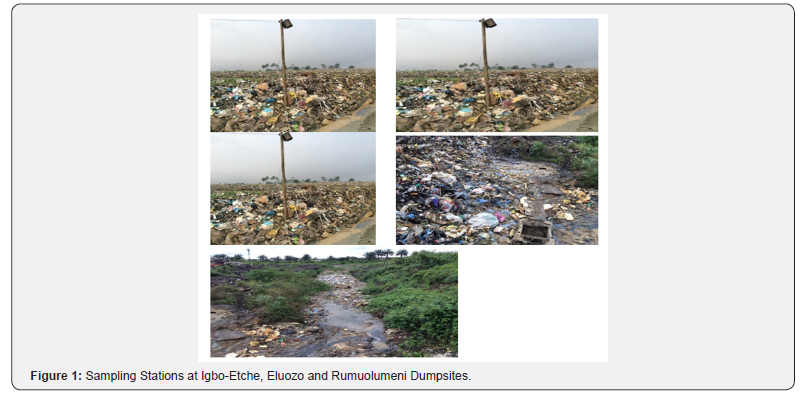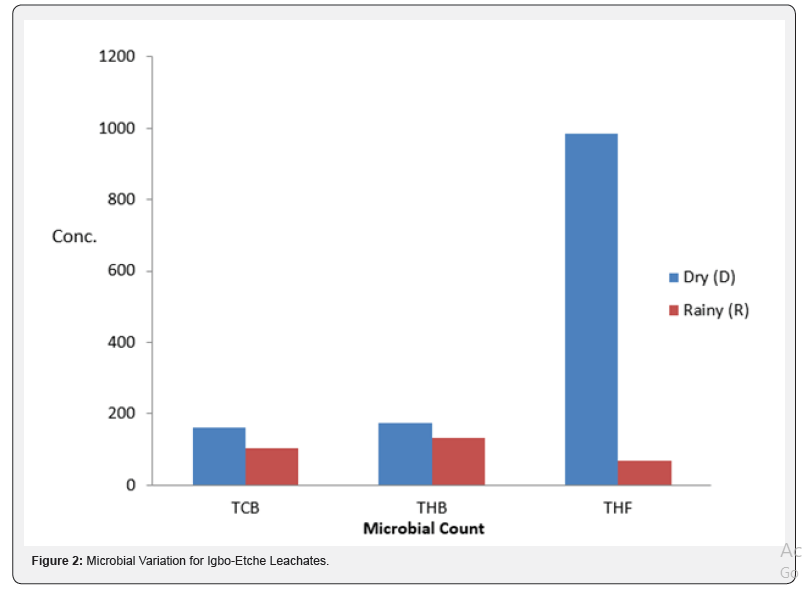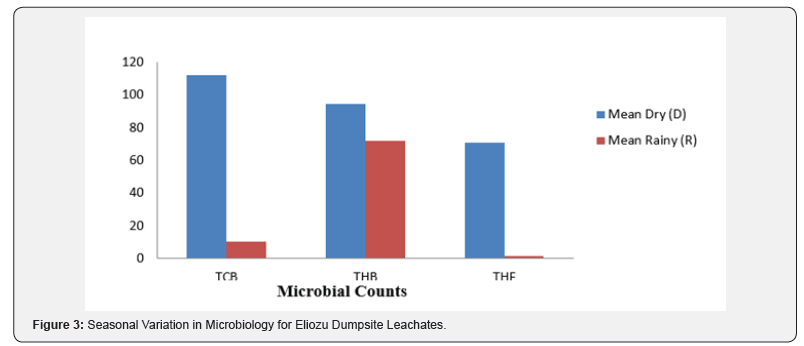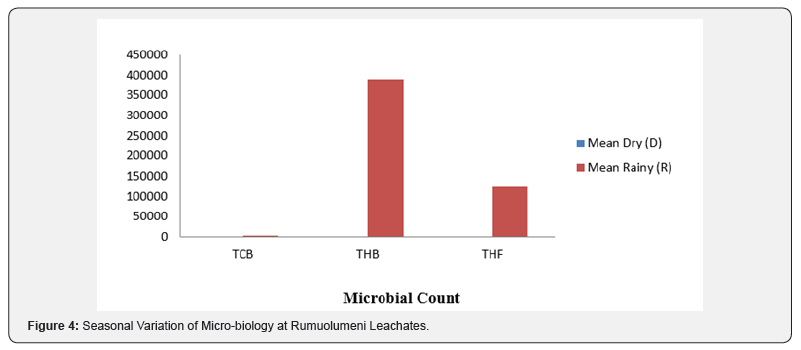Water Bacteriology of Leachates from Government Approved Dumpsites in Port Harcourt and Environs, Rivers State, Nigeria
Iyama William Azuka1 and Edori Onisogen Simeon2*
1School of Basic Studies, Rivers State College of Health Science and Technology, Nigeria
2Department of Chemistry, Ignatius Ajuru University of Education, Nigeria
Submission: September 23, 2019; Published: October 30, 2019
*Corresponding author: Edori OS, Department of Chemistry, Ignatius Ajuru University of Education, Port Harcourt, P.M.B.5047, Nigeria
How to cite this article: Iyama William Azuka, Edori Onisogen Simeon. Water Bacteriology of Leachates from Government Approved Dumpsites in Port Harcourt and Environs, Rivers State, Nigeria. Int J Environ Sci Nat Res. 2019; 22(2): 556084.DOI: 10.19080/IJESNR.2019.22.556084
Abstract
This study was carried out to determine the levels of physical parameters from some selected dumpsites in Port Harcourt metropolis. The study of water bacteriology was to establish a trend with the other physicochemical parameters. Leachates from the 3-selected dumpsites were analyzed and compared with the seasons, controls and established standards using descriptive and analytical designs. Integrated samples were collected during both wet and dry seasons and analyzed for TCB, THB, and THF. The use of 2-way ANOVA, t-test, graphs and mean variation were applied to explain trend and variations. The results show that there was no significant difference in temporal dimension (seasonally) but high-level spatial variation (stations) in most parameters. There was a positive presence of TCB, THB, THF and helminthes in the leachates showing anthropogenic inputs. Government can make conscious efforts to recover highly contaminated dumpsites like these by financing active remediation processes, enforceable laws, regulations and public health enlightenment and sensitization.
Keywords: Bacteriological parameters Seasons Leachate Dumpsite Water Anthropogenic
Introduction
Open and indiscriminate waste disposal is the commonest way of managing waste in our towns and cities. The present-day notice of massive waste dumps is probably due to population explosion in the urban cities. According to Weli et al. [1], Landfilling has been one of the best forms of waste disposal management as it reduces environmental unfriendliness mostly for reducible, recyclable and combustible wastes. Research has shown that about 75% of the developing world countries practice open dumping which is considered old-fashioned and even unfriendly to the ecosystem [2].
According to Inyang et al. [3], leachates are liquids emanating from water collecting contaminants as it flows through wastes and agricultural applications such as fertilizers and pesticides. According to Anikwe and Nwobodo, a major environmental issue in our cities today is improper solid waste handling and disposal. Soils differ in their responses to organic wastes amendments which spur the need to study or the impact of organic wastes on the properties of the soil. Though Njoku et al. [4] posits that disposal of organic waste into agricultural land improves its prop erties, our major cities do not sort generated waste as to identify the unit impact of their inorganic components. Pollutants even in waste dumps are potential threats to the ecosystem.
The use of the soil must be well articulated as various man-made activities may pollute and contaminate it causing colossal damage to the ecosystem (Land or soil, air and water). According to Amadi et al. [5], our dumpsites in Nigeria are abandoned burrow pits and acquired areas which were not selected following any legal environmental impact assessment studies. Afterwards, these waste dumps become hazards and potential threats to the soil and groundwater as a result of percolation of leachates with time [6].
This research work is an attempt to analyze the physical parameters of the leachates from selected government approved dumpsites within Port Harcourt metropolitan Murthya et al. [7], posits that assessment of soil pollution is potentially hard when pollutants emanate from different sources as their results become vast circulated in different proportions. The complication arising from the impacts serves a major intellectual property to reAbstractsearchers and the population at large, for future references. This is because hazardous materials which dissolve in the leachate may contaminate soil and groundwater [8].
High mean percentage variation from control stations of water quality parameters for TDS, TCB, were observed [9]. Leachate from waste dumpsites is a major environmental concern to the researcher due to its negative impact such as being genotoxic as corroborated by Singh et al. [10] on similar area. This research is an attempt to analyze the impact of leaching on the water bacteriology parameters and the ecosystem of the run-off water in the active dumpsites in Port Harcourt, Rivers State, Nigeria. Leachates are water that flows and passes through waste disposal sites leading to contamination [11]. USEPA [12] posits that the contamination hence pollution of water (surface and underground), soil and the atmosphere influences human health and ecological impacts which then add to the breakdown and destruction of important natural resources. One very pertinent concept in most developing countries is the nature of their dumpsites as most are not properly lined and shallow hollow dug pits devoid of environmental impact assessment studies [5]. Improper management of waste from the point of generation to disposal results in the contamination of soil and groundwater [13]. Similarly, Shaikh et al. [13] posits that presence of water pollutants in all the reported samples shows ascientific relationship between solid waste, leachate and groundwater.
Port Harcourt is the capital city of the oil rich Niger Delta State of Rivers Nigeria. It lies along the Bonny River and Longitudes of 6°59’55” and Latitude of 4°47’21”. Port Harcourt has a population of about 1,382,592 as of 2006 which has grown to 1,865,000 inhabitants as at 2016 [14]. This is about 34% increase in population within a period of 10 years.
The area covered by Port Harcourt was 15.54km2 in 1914 but grew to 360km2 by the 1980s due to modernization and urbanization [15]. The study by Ogbonna et al. [15] estimated a total of 207.3 tons of solid waste generation giving per capita annual waste generation rate of 0.53 tons equivalent to a waste generator rate of 1.45kg per capita daily. Similarly, 16.1 percent of cartons, papers and food remnants had 14.4 percent whereas 26.6 percent of total waste generated respectively.
Materials and Methods
Three active dumpsites were chosen for this study within the Port Harcourt Metropolis. These are located primarily in two local governments of Obio Akpor and Etche. The geographical location of the study sites and sampling locations are shown in Table 1.

The longitudinal survey research design was adopted because samples were collected at different points or stations in time. Integrated samples were collected using the simple random sampling technique but controlled by and availability of leachates. Leachate water samples were collected from two stations labeled A and B whereas the third station labeled C was taken some distances away from the dumpsite. The control samples were taken from pockets of water retained due to rains (wet season) whereas nearby surface pond water was used as control during the dry season especially in the Igbo-Etche dumpsite. Sampling stations were scientifically noted using a Germin 45 Global Positioning System (GPS).
The biological samples for analysis were collected in sample vials and kept in cooler of ice to maintain the integrity. These were finally transported same day to the laboratory at Diamond standard integrated services (Nig.) Limited located at 2 pure water road, Rumuodara, Port Harcourt. In the laboratory, samples were made to maintain a temperature of 4° C until analysis was done. Data from the field were tabulated and analyzed using SPSS version 11.0 software package [16]. This included mean, standard deviation, mean variation, t-test, ANOVA and 95% confidence intervals. Similarly, statistical difference between the means of leachates during dry and rainy seasons were done using t-test at p-value less than and equal to 0.05, p≤0.05 [16].
Results and Discussion
Results of analysis from leachates obtained in 3 selected dumpsites in Port Harcourt Metropolis; Igbo-Etche, Eluozo and Rumuolumeni for both the dry and rainy season is presented in tables below precisely from Table 2-7. Table 2 shows the results ofthe sampling locations for TCB, THB, THF and Helminthes whose mean values are 161±70.71, 173±19.80, 98.5±19.09 and positive (+ve) respectively for the dry season at Igbo-Etche dumpsite. The microbial analytical result reveals the mean values for TCB (112±156.27), THB (94.5±94.05), THF (71±19.80) and Helminthes (+ve) as shown in Table 3 for Eluozo by dry season. Similarly, Table 4 shows the concentration of microbial count for the dry season as recorded for Rumuolumeni study station. The mean concentrations for TCB, THB, THF and Helminthes were 217±7.81, 104±38.9, 27±6.4 and positive (+ve) respectively. Table 5 showed the concentrations of microbial count for Eluozo dumpsite samples during the rainy season. Table 6 showed the summary for the concentrations of microbial count for Igbo-Etche dumpsite. These are for Total Coliform, THB, THF, and Helminthes as 102±18.38, 133±5.66, 67±31.11, +ve respectively. For Total Coliform, THB, THF, Helminthes and THF results are 57±78, 72±69.3, +ve and 1.77 x 105 ±0.00023 respectively. Table 7 is a record of the concentrations of microbial count for the rainy season at the Rumuolumeni dumpsite. The Table also showed the mean concentration for TCB, THB, THF, Helminthes as 4290±1598, 3.9x105±7.1x105, 1.25x105±1.05x105 and +ve respectively Figure 1.







The following microbial analyses were done to ascertain the trend across the study dumpsites and their seasonal variations: Total coliform bacteria (TCB), Total heterotrophic bacteria (THB), Total Heterotrophic fungi (THF) and Helminthes. Total coliform bacteria recorded mean concentrations of 161 112 and 217 at the Igbo-Etche, Eluozo and Rumuolumeni dumpsites by the dry season. In a similar vein, the mean variations (%) were 31.06, 99.11 and 53.46 at the corresponding dumpsites above. This variation is a perfect indication of anthropogenic inputs as compared to the control. Similarly, at the Igbo-Etche, Eluozo and Rumuolumeni dumpsites, the concentration of TCB in the leachates are for rainy season 102, 57 and 4290 as their corresponding mean variations (%) were 5.88, 98.25 and 41.72. The sampling points showed variation of interest especially at station Ao compared to station Bo during the rainy season at the Eluozo sampling point. The results are recorded in Tables 2- 4 (dry) and Table 5- 7 (rainy season). This is a clear indication of the presence of fecal waste in the sampling points and dumpsite.
The average concentration of TCB was higher during the rainy season may be due to the dilution and washing of fecal coliform to form leachates but principally the result has shown high concentration of TCB at the Rumuolumeni dumpsite. The present of TCB indicates pollution. Bacteriological examinations are done to determine the sanitary qualify and extent of waste pollution [17].
Total heterotrophic bacteria (THB) results are shown in Tables 2-4 during the dry season. The result showed that the mean concentration of THB at the Igbo-Etche dumpsite was 173(CFU/100ml), Eluozo as 94.5 and Rumuolumeni as 104. Similarly, during the rainy season, Igbo-Etche, Eluozo and Rumuolumeni recorded THB concentration of 133, 72 and 3.9x105 respectively. This trend is also repeated having higher concentrations at the Rumuolumeni dumpsites during the rainy season. The mean variations (%) from the control shows that for Igbo-Etche, Eluozo, Rumuolumeni during the dry and rainy season, the calculations in Table 2 13 were 34.22, 66.14, 26.92 and 6.99, 61.11 and 30.77 respectively. This relatively low mean variation is an indication of low presence in dumpsite though indicates pollution. Similarly, the recorded concentration for total heterotrophic fungi and helminthes are present in different concentrations all in CFU/100ml. Results shown at the Igbo-Etche, Eluozo and Rumuolumeni dumpsites are 98.5, 71, 27 (dry) and 67, 1.77x105, 1.25x105 whereas helminthes were positive (five) showing their presence. The result also shows the calculated mean deviations (%) for total heterotrophic fungi compared to the control stations for Igbo-Etche, Eluozo and Rumuolumeni at the dry season as 19.80, 7.80, 55.56 and 20.90, 99.15 and 98.80 for the rainy season. The result shows that the leachates from the dumpsites of Rumuolumeni during the dry season, Eluozo and Rumuolumeni by the rainy season were highly polluted by the presence of THF. The seasonal variations show that the rainy season was more affected by the microbial count. Using the t-test analysis, there was no significant relationship in the temporal variations between the dry and rainy seasons for all the parameters using the t-test and corroborated by a 2-way ANOVA (SPSS) and STATA package. Conversely, there were several spatial variations between the means of the sample and control stations as illustrated using the % mean variation. During the dry season at the Igbo-Etche dumpsite, virtually all the parameters recorded high percentage mean variation from the control similar to those by the rainy season except TCB (5.88), THB (6.99), and THF (20.90). At the Eluozo dumpsite, the dry season recorded low percentage mean variations in THF (8).
Rumuolumeni dumpsite recorded lower values of percentage mean variation by the dry season for only THB (26.92%) whereas other parameters measured were well above 50%, whereas by the rainy season, relatively lower percentage variation were observed for TCB (41.7%) and THB (30.77) but the values exceeded the permissible limits for surface water [18]. This study adopted less than 50% mean variation as low whereas above 50% as high. The seasonal variation of the studied parameters for Igbo-Etch, Eliozu and Rumuolumeni are shown in Figure 2- 4 respectively.



Conclusion
The microbiology analysis showed relatively higher TCB, THB and THF during the rainy season for the dumpsite’s leachates across the seasons (temporal dimensional). The presence of these parameters in leachates of the study dumpsites is an indication of threat to surface, ground water and health hazards to the ecosystem. Therefore, efforts must be made by concerned authorities to reduce human inputs especially fecal coliform. All the parameters measured were below the permissible limits for surface water except those of Rumuolumeni which exceeded the limits during rainy season.
References
- Weli VE, Adekunle O (2014) Air Quality in the Vicinity of a Landfill Site in Rumuolumeni, Port Harcourt, Nigeria. Journal of Environment and Earth Science 4 (10): 1-10.
- Kumar S, Mondal AN, Gaikwad SA, Devotta S, Singh RN (2004) Qualitative Assessment of Methane emission inventory from municipal solid waste disposal sites: A Case Study. Atmospheric Environment 38(29): 4921-2929.
- Inyang LD, Onwuteaka JN (2004) Environmental ready reference. volume 1, (1st edn), Kehnalf and Co publishers, Port Harcourt, Nigeria.
- Njoku C (2015) Effect of waste on selected soil properties in Abakaliki South Eastern Nigeria. International Journal of Plant and Soil Science 4(1): 94-99.
- Amadi AN, Ameh MI, Jisa J (2010) The impact of dumpsites on groundwater quality in Markurdi Metropolis, Benue State. Natural and Applied Science Journal 11(1): 90-102.
- Praveena GS, Rao PVV (2016) Impact of leachate on soil properties in the dumpsite; A case study of Greater Visakhapatnam. International Journal of Engineering Research and General Science 4(1): 235-241.
- Partha V, Murthya NN, Saxena PR (2011) Assessment of heavy metal contamination in soil around hazardous waste disposal sites in Hyderabad city (India): natural and anthropogenic implications. E3 Journal of Research Management 2(2): 27-34.
- Adelekan BA, Alawode AO (2011) Contributions of municipal refuse dumps to heavy metals concentrations in soil profile and groundwater in Ibadan Nigeria. Journal of Applied Bioscience 40: 2727-2737.
- Iyama WA, Boisa N, Maduelosi J (2016) Physico chemical analysis of leachates from 3 selected dumpsites in Port Harcourt, PGD thesis submitted to the department of chemistry, Rivers University of Science and Technology, Port Harcourt, Rivers State, Nigeria.
- Singh A, Chandra S, Kumar Gupta S, Chauhan LK, Kumar Rath S (2007) Mutagenicity of leachates from industrial solid waste using Salmonella Reverse Mutation Assay. Ecotoxicology and Environmental Safety 66(2): 210-216.
- Bhatia SC (2007) Environmental Chemistry. (1st edn), CBS Publishers and Distributors, Darya Gary, New Delhi, India.
- USEPA (2002) United States Environmental Protection Agency. Environmental and Economic Benefit Analysis of Final Revisions to the National Pollution Discharge Elimination System Regulation and the Effluent Guidelines for Concentrated Animal Feeding Operations.
- Shaikh PR, Bhosle AB, Yannawar VB (2012) The Impact of Landfill on Soil and Groundwater Quality of the Nanded City, Maharashtra. Researcher 4(7): 56-63.
- Arizona Ogwu LC (2016) Port Harcourt PDP Rally Stampede: Irregular or Deregulated Police Action? Nigeria in America.
- Ogbonna DN, Amangabara GT, Ekere TO (2007) Urban solid waste generation in Port Harcourt Metropolis and its implication for waste management. Management of Environmental Quality. An International Journal 18(1): 71-88.
- Van G, Lloyd D, Patrick J, Thomas L (2004) Biostatistics: a methodology for the health sciences. (2nd edn), John Wiley & Sons, United States of America.
- APHA, AWWA, WEF (1995) American Public Health Association Water Works Association and Water Environment Federation. Standard methods for the examination of water and wastewater. (20th edn), Washington DC, USA.
- WHO (2009) World Health Organization, Guidelines for Drinking Water Quality.






























